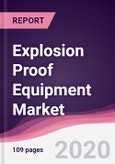What is Explosion Proof Equipment?
Hazardous locations are places where there is risk of fire or explosion hazards occurring due to presence of flammable gases, flammable liquid–produced vapors, combustible liquid–produced vapors, combustible dusts, or ignitable fibers/ flying particles present in the air in quantities sufficient to produce explosive mixtures which may ignite on exposure to extreme conditions of temperature and pressure. In such conditions it is necessary to use specialized equipment which is safe to work in order to minimize the risk of explosion. Even a small spark could lead to such hazardous event.
The explosion-proof rating is assigned on the basis of certain criteria i.e., for an enclosure to be rated as explosion proof it should be able to contain any explosion originating within self and moreover prevent internal sparks from igniting vapors, gases, dust, or fibers in the air surrounding it. Hence, explosion-proof electrical equipment does not essentially mean that it can bear an exterior explosion; rather in most of the cases it is the equipment’s ability to prevent an internal spark or explosion from causing a much larger blast.
What are the major applications for Explosion Proof Equipment?
Explosion proof equipment are majorly used in cable glands, junction boxes and enclosures, lifting systems, lighting systems, material handling systems, panel boards, motor starters, switches & sockets, surveillance and monitoring systems, switchgear, HVAC systems and many other systems.
Explosion Proof Equipment Market
Market Research and Market Trends of Explosion Proof Equipment Ecosystem
Equipment protection level (EPL) is a new factor introduced into the use of explosion proof equipment. This approach, takes factors into account, such as the consequence or impact of an explosion, and the selection of the protection level required is left up to the system designer.
New products and technologies including explosion-proof wireless LAN solutions, explosion proof tablets, explosion proof IP cameras have recently being budding indicate that with the digital technologies making big strides, the same amount of effort is required in making them fit for application in hazardous or explosion prone situations.
There has been an increase in the number of manufacturing plants which have been setup especially in the APAC region in recent times and so has been the concern related to safety of working conditions. To be certified as explosion proof, the enclosure must be strong enough not to fracture or distort under the internal pressures generated in order to contain explosions and prevent propagation.
Who are the Major Players in Explosion Proof Equipment market?
The players profiled in the report include GE Equipment, Hatch Transformers, Osram Sylvania, Philips Equipment Holding, Chamlit Equipment UK, Victor Equipment, WorkSIte Equipment, Eaton Corporation PLC (Cooper Industries Inc.), Emerson Electric Co. (Appleton Group LLC), Rockwell Automation, Inc. (Allen-Bradley), R. Stahl Ag, Pentair PLC, ABB Ltd. (Thomas & Betts Corporation)
What is our report scope?
The report incorporates in-depth assessment of the competitive landscape, product market sizing, product benchmarking, market trends, product developments, financial analysis, strategic analysis and so on to gauge the impact forces and potential opportunities of the market. Apart from this the report also includes a study of major developments in the market such as product launches, agreements, acquisitions, collaborations, mergers and so on to comprehend the prevailing market dynamics at present and its impact during the forecast period 2018-2024.
Key Takeaways from this Report
- Evaluate market potential through analyzing growth rates (CAGR %), Volume (Units) and Value ($M) data given at country level – for product types, end use applications and by different industry verticals.
- Understand the different dynamics influencing the market – key driving factors, challenges and hidden opportunities.
- Get in-depth insights on your competitor performance – market shares, strategies, financial benchmarking, product benchmarking, SWOT and more.
- Analyze the sales and distribution channels across key geographies to improve top-line revenues.
- Understand the industry supply chain with a deep-dive on the value augmentation at each step, in order to optimize value and bring efficiencies in your processes.
- Get a quick outlook on the market entropy – M&A’s, deals, partnerships, product launches of all key players for the past 4 years.
- Evaluate the supply-demand gaps, import-export statistics and regulatory landscape for more than top 20 countries globally for the market.
Table of Contents
Methodology

LOADING...








